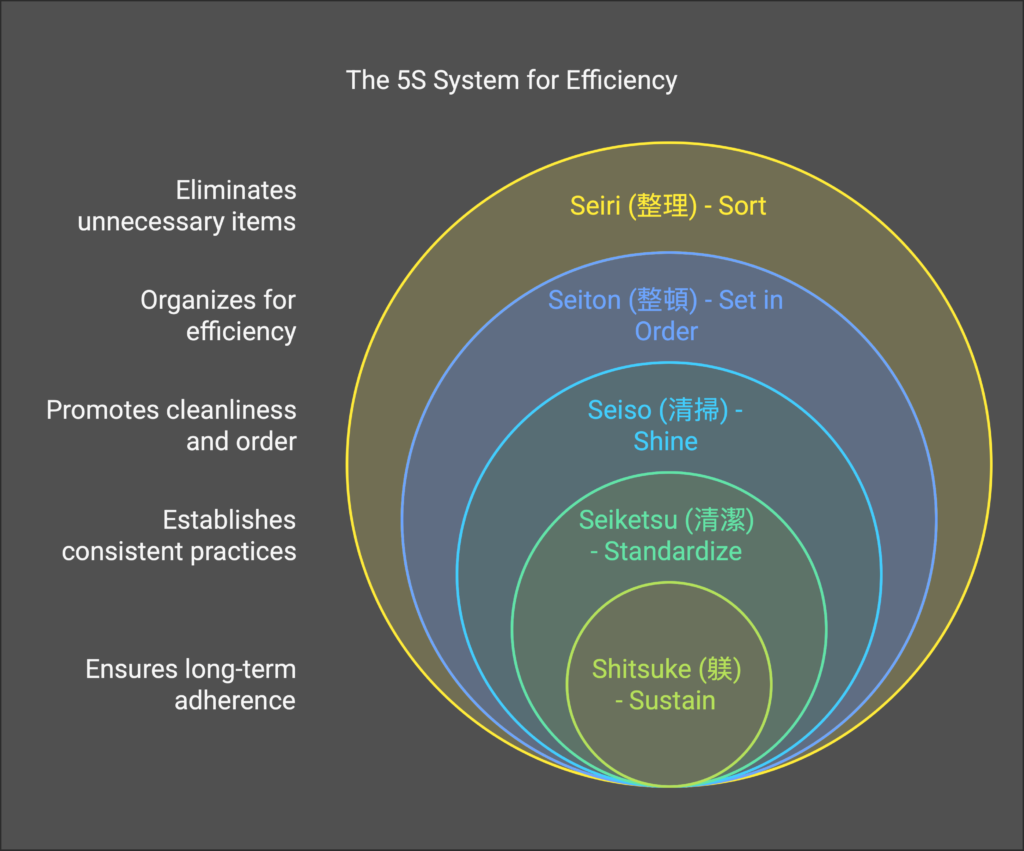How the 5S System Boosts Productivity
Ever feel like your workspace is working against you? Cluttered desks, lost files, and chaotic processes drain your energy. But there’s a simple system that’s been transforming workplaces for decades: The Japanese 5S Method.
One Topic: The 5S System Simple Steps to Maximum Efficiency
Originally designed for manufacturing, 5S is now used in offices, digital spaces, and even homes. It’s a step-by-step system for efficiency and organisation—so you spend less time searching and more time doing. Even though it started and used by Toyota and hospitals worldwide, it’s not just for factories. Here’s how to use it to boost focus, slash stress, and save 30+ minutes daily. It’s built on five pillars, each starting with ‘S’ in Japanese.
Let’s break these down: The 5S System
- Sort (Seiri): Get rid of what you don’t need. Clutter slows you down. Ask yourself, Does this item serve a purpose? If not, discard it.
- Set in Order (Seiton): “A place for everything and everything in its place.” Organise based on frequency of use. Need it often? Keep it within reach.
- Shine (Seiso): Keep your workspace clean. It’s not just about appearances—regular maintenance prevents problems before they start.
- Standardize (Seiketsu): Turn the first three steps into routines. Label things, create checklists, and set schedules to keep order effortless.
- Sustain (Shitsuke): The hardest step: making it stick. Develop habits and workplace culture that reinforce the system daily.

Why 5S Works
A clean, organized environment improves focus, productivity, and even morale. Studies show that cluttered spaces increase stress and lower efficiency. The 5S method eliminates unnecessary distractions so you can work smarter, not harder. The beauty of 5S lies in its simplicity and adaptability.
Beyond Workspaces: 5S in Daily Life
- Digital Files: Organize folders, delete junk, and create a logical structure for easy access.
- Email Inbox: Unsubscribe from noise, create filters, and keep only what’s necessary.
- Home Spaces: Apply the system to your kitchen, garage, or wardrobe—no more searching for lost items!
Modern Variations of 5S System
- 6S Method: Some organizations add “Safety” as the sixth S. Because what’s efficiency without well-being, right?
- Personal Kanban: While not directly related to 5S, this visual workflow management tool shares the same spirit of organization and efficiency.
Implementing 5S System in Your Life
Pick one area—your desk, a single drawer, or even your phone apps—and apply the 5S system. Start small and build momentum.
- Choose one area – your desk, a single drawer, or even your email inbox.
- Go through the 5S process methodically.
- Document your process and results.
- Expand to other areas as you see success.
Remember, 5S isn’t a one-time event – it’s a continuous journey of improvement. It’s about creating a workspace that works for you, not against you.
5S System Example : Email Management using 5S principles
- Sort (Seiri): Delete unnecessary emails and unsubscribe from irrelevant newsletters, reducing inbox clutter.
- Set in Order (Seiton): Create folders and use labels or tags to categorise emails by project, priority, or status for easy retrieval.
- Shine (Seiso): Regularly clean out old or unnecessary emails, similar to decluttering an inbox.
- Standardise (Seiketsu): Establish a routine for processing emails, such as checking at specific times and using templates for common responses.
- Sustain (Shitsuke): Use automation tools or scripts to maintain email organisation, like automatically sorting incoming messages into appropriate folders.
Read last week’s JustDraft newsletter about Breaking the Pattern.
Two Quotes
Your environment shapes your focus—clear space, clear mind.
Efficiency is doing things right; effectiveness is doing the right things.
One Passage From A Book
“The first step in any improvement process is to identify waste. Waste is any activity that does not add value to the customer. The 5S system is a foundational tool in this process. Without organization, efficiency is impossible. By maintaining a clean and structured environment, teams can spot inefficiencies, reduce errors, and increase productivity.”
📚 “The Toyota Way” by Jeffrey K. Liker
P.S. Found this useful? Share it with someone who needs a productivity boost!

